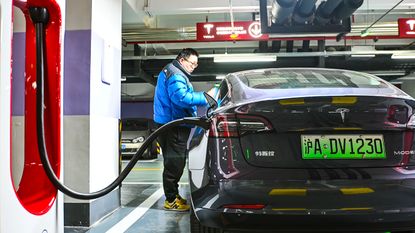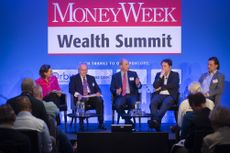Think Tesla is a bubble? This might be the best way to bet on it bursting
The huge rise in Tesla’s share price means that, by market value, it’s now the sixth-largest company in the US and and the world’s biggest car-maker. Shorting it is a dangerous game. But there are other ways to bet on the bubble bursting. John Stepek explains how.


Quick reminder – Merryn will be interviewing Charles Plowden of Baillie Gifford on Thursday. If you haven’t already registered to watch it, make sure you don’t miss out!
Back to this morning – I saw a very striking chart on Twitter the other day. Dylan Grice of Calderwood Capital (an occasional MoneyWeek contributor) noted that electric car-maker Tesla is now valued at roughly the same amount as the entire S&P 500 oil sector.
“The equity market seems to be saying that oil has no future, and that energy transition is basically here. I feel like that’s jumping the gun.” Needless to say, I agree.
Subscribe to MoneyWeek
Subscribe to MoneyWeek today and get your first six magazine issues absolutely FREE

Sign up to Money Morning
Don't miss the latest investment and personal finances news, market analysis, plus money-saving tips with our free twice-daily newsletter
Don't miss the latest investment and personal finances news, market analysis, plus money-saving tips with our free twice-daily newsletter
A future of self-driving hover-cars
One day our cars will all be electric. One day they will all run on batteries with incredibly long life expectancies. One day said batteries will all be charged up via the wind and the rain and the sun.
In short, we will drive (or rather, be driven) to and from our destinations in weather-powered vehicles, and the only environmental impact will be the bits of our cars’ tyres that rub off on the roads, which will no doubt then become the next big headline enemy we have to deal with, at which point we’ll finally get the hover-cars we’ve all been waiting for since the 1950s (or the 1980s, if Back to the Future is more your era).
That all sounds lovely and I can’t wait, but it isn’t happening today. And it isn’t happening tomorrow. It may take a while longer and, in the meantime, as one Robert Burns once put it, “the best laid schemes o’ mice an’ men gang aft agley”. In other words, the market should probably be pricing in a little bit of uncertainty, given that, as Grice points out, the energy transition hasn’t actually arrived yet.
Yet, things still seem heavily weighted towards the Tesla end of the argument. There are some utterly extraordinary statistics in John Authers’ Bloomberg newsletter this morning: Tesla is now the sixth-largest company in the US by market value; it is the world’s largest car maker on the same measure.
Not only that, when it joined the S&P 500 index last month, it single-handedly rendered “Wall Street’s estimates for five-year earnings growth more optimistic than they had ever been”. In other words, analysts expect Tesla’s earnings to grow so rapidly that its inclusion in the S&P 500 has distorted estimates for the entire index.
Anyway. Is it a tech bubble? Is it a green bubble? Is it just a Tesla bubble? Who knows? Shorting Tesla (or anything in its vicinity) feels about as sensible as running out in front of one of its cars just after the driver has decided to stick the autopilot on and snatch 40 winks.
A better way to express and profit from scepticism on the Tesla bubble is to look for “anti-bubbles”. And the most obvious one here is not so much in the other car makers (though they might be worth looking at), but in the old-fashioned energy sector.
How to invest in oil
Markets are starting to wake up to the fact that the death of oil might have been over-exaggerated. When the price of a vital commodity turns negative (as oil did briefly in April last year) then even the most gloomy of oil analysts had to feel that something of a bottom might have been reached.
Since then, we’ve had ongoing abstention by producers, with Saudi Arabia springing a surprise production cut on markets earlier this month. The oil majors are focusing on grabbing headlines for their “clean” investments. Just this morning, Shell has bought Ubitricity, which owns the biggest public electric vehicle charging network in the UK.
And yet, life is returning to oil markets, even as the price steadily recovers from the tough days. As Justin Jacobs in the FT reports, the number of rigs for drilling oil and gas in the US has risen for nine weeks in a row and is now about 40% higher than at its low point in summer 2020. Oil services companies have been reporting better than expected fourth-quarter earnings, as activity starts to pick up.
As ever, the market has anticipated the rebound, with the S&P oil and gas equipment and services sector up about 60% in the last three months alone. And yet, the industry really is recovering from an extremely low ebb – oil producers are not keen to splash the cash yet. As Jacobs notes, the biggest driver of the industry in recent years has been desperately-expanding US shale producers – and those days are over now. Shale players, having been told off by their investors, are “now consolidating and shifting to an emphasis on profits over production growth”.
That in turn indicates that supply of oil will recover more slowly than demand for oil. So while in the long run, oil may well be doomed in favour of electricity, I suspect there’s at least one more boom-and-bust cycle to squeeze some juice out of here.
What does it all suggest? You can invest in oil in a number of different ways. My colleague Dominic has always viewed BHP Billiton as the best bet (yes, it’s best known as a miner but it gets a lot of its money from the sector and appears to be a better play on the oil price than BP or Shell).
That’s just one idea. We’ll have more in MoneyWeek magazine as we look more into the burgeoning new commodities supercycle in coming issues. If you’re not already a subscriber, get your first six issues free here.
John is the executive editor of MoneyWeek and writes our daily investment email, Money Morning. John graduated from Strathclyde University with a degree in psychology in 1996 and has always been fascinated by the gap between the way the market works in theory and the way it works in practice, and by how our deep-rooted instincts work against our best interests as investors.
He started out in journalism by writing articles about the specific business challenges facing family firms. In 2003, he took a job on the finance desk of Teletext, where he spent two years covering the markets and breaking financial news. John joined MoneyWeek in 2005.
His work has been published in Families in Business, Shares magazine, Spear's Magazine, The Sunday Times, and The Spectator among others. He has also appeared as an expert commentator on BBC Radio 4's Today programme, BBC Radio Scotland, Newsnight, Daily Politics and Bloomberg. His first book, on contrarian investing, The Sceptical Investor, was released in March 2019. You can follow John on Twitter at @john_stepek.
-
 Rightmove: Asking prices edge closer to record peak
Rightmove: Asking prices edge closer to record peakAsking prices have been driven up by the top-end of the market, Rightmove has found. But how does the situation look in your area?
By Vaishali Varu Published
-
 Coventry Building Society bids £780m for Co-operative Bank - what could it mean for customers?
Coventry Building Society bids £780m for Co-operative Bank - what could it mean for customers?Coventry Building Society has put in an offer of £780 million to buy Co-operative Bank. When will the potential deal happen and what could it mean for customers?
By Vaishali Varu Published
-
 Halifax: House price slump continues as prices slide for the sixth consecutive month
Halifax: House price slump continues as prices slide for the sixth consecutive monthUK house prices fell again in September as buyers returned, but the slowdown was not as fast as anticipated, latest Halifax data shows. Where are house prices falling the most?
By Kalpana Fitzpatrick Published
-
 Rents hit a record high - but is the opportunity for buy-to-let investors still strong?
Rents hit a record high - but is the opportunity for buy-to-let investors still strong?UK rent prices have hit a record high with the average hitting over £1,200 a month says Rightmove. Are there still opportunities in buy-to-let?
By Marc Shoffman Published
-
 Pension savers turn to gold investments
Pension savers turn to gold investmentsInvestors are racing to buy gold to protect their pensions from a stock market correction and high inflation, experts say
By Ruth Emery Published
-
 Where to find the best returns from student accommodation
Where to find the best returns from student accommodationStudent accommodation can be a lucrative investment if you know where to look.
By Marc Shoffman Published
-
 Best investing apps
Best investing appsWe round up the best investing apps. Looking for an easy-to-use app to help you start investing, keep track of your portfolio or make trades on the go?
By Ruth Emery Last updated
-
 The world’s best bargain stocks
The world’s best bargain stocksSearching for bargain stocks with Alec Cutler of the Orbis Global Balanced Fund, who tells Andrew Van Sickle which sectors are being overlooked.
By Andrew Van Sickle Published
-
 Revealed: the cheapest cities to own a home in Britain
Revealed: the cheapest cities to own a home in BritainNew research reveals the cheapest cities to own a home, taking account of mortgage payments, utility bills and council tax
By Ruth Emery Published
-
 UK recession: How to protect your portfolio
UK recession: How to protect your portfolioAs the UK recession is confirmed, we look at ways to protect your wealth.
By Henry Sandercock Last updated